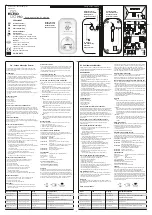
5808/5808C
smoke/heat detector
MOUNTING INSTRUCTIONS
First, determine the best location for the smoke detector, a location that provides strong
wireless transmission paths and proper smoke detection. A GOOD TRANSMISSION PATH
MUST BE ESTABLISHED FROM THE PROPOSED MOUNTING LOCATION BEFORE
PERMANENTLY INSTALLING THE DETECTOR. To check, perform the test described in the
TESTING TRANSMITTER SIGNAL section of this
manual. To mount the detector:
1. Once a suitable location has been determined,
install the mounting bracket on the ceiling or on the
wall (if local ordinances permit). Use the two screws
and anchors provided.
2. Prior to mounting the detector to the mounting
bracket, the system must “enroll” the detector’s ID.
See the Programming section for the steps to follow.
3. Turn the detector immediately after completing the installation and refer to the control
system’s instructions for additional information concerning the use of wireless smoke
detectors.
Tamper protection
This detector has a built-in tamper switch that will cause a CHECK signal to be displayed at
the console of the detector if it is removed from its installation bracket. The mounting bracket
can also be made tamer-proof by breaking off the smaller tab at the scribed line, thus
preventing removal of the detector without a tool. To remove the detector, use a small
screwdriver to depress the tamer-proof tab and turn the detector counter-clockwise.
Testing
Note: Before testing, notify the proper authorities that the smoke detector system is
undergoing maintenance and will temporarily be out of service. Disable the zone or system
undergoing maintenance to prevent unwanted alarms.
Detectors must be tested after installation and following periodic maintenance. The 5808
may be tested as follows:
A. Test switch
1. A recessed test switch is located on the detector housing
2. Push and hold the recessed test switch with a 0.1” maximum diameter tool (an
alien wrench or small screwdriver)
B. Test module (Model No. MOD400R)
The MOD400R test module can be used with a DMM or analog voltmeter to check the
detector sensitivity as described in the test module’s manual.
An ADEMCO Group Company






















